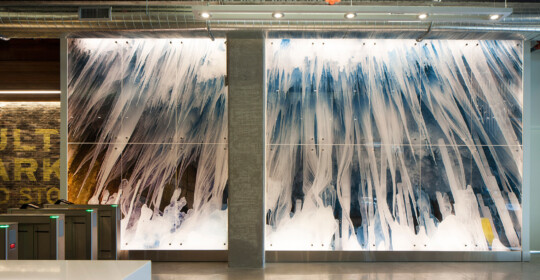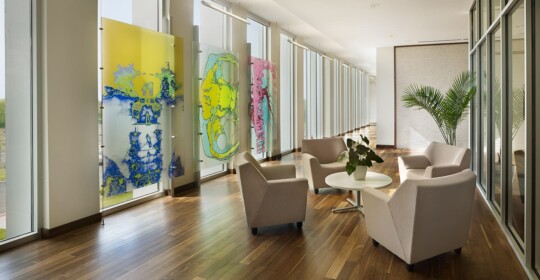
Peter Cooper Village Stuyvesant Town
Project Challenge:
After the offices of Peter Cooper Village Stuyvesant Town (PCVST)—a New York City housing complex—were damaged in Hurricane Sandy, the company’s management required a new workspace and quickly. But they also wanted a lasting office that would suit their needs as an organization while retaining a sense of overall brand cohesion. “Since this company’s employees are in and out of the office all the time, we thought about how to blend different work styles and share office space,” says Justyna Mrowiec-Chun, a designer from the architectural firm FXFOWLE in charge of the project. The challenge did not end there. “Due to its unique location on a steeply sloped site, the building transitions from an above-grade public entrance to a below-grade employee entrance,” says Mrowiec-Chun. Within these subterranean areas, the team needed to create an open, airy space with very little natural light to work with.
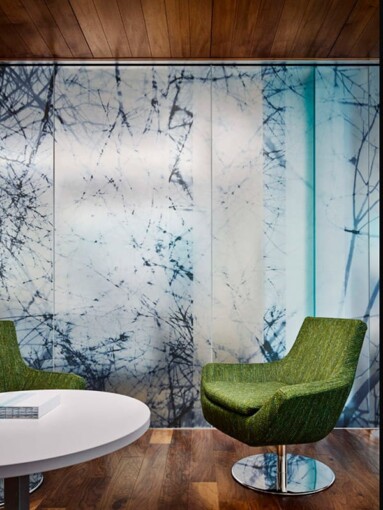
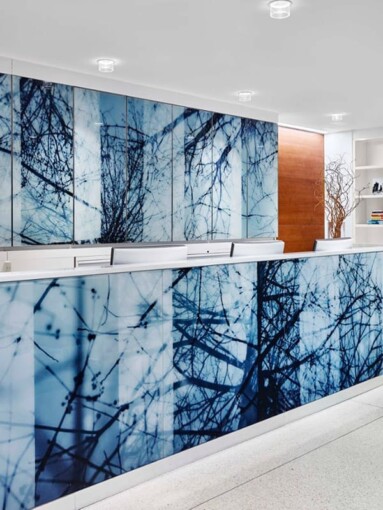
Skyline Design’s Solution:
FXFOWLE engaged Skyline Design to help create an environment that simultaneously embodies the attributes of the business and infuses a sense of expansive openness. Glass was selected to make the most of the natural light that filters into the space through strategically placed skylights. The Neil’s Branches artwork by artist Doug Fogelson was chosen from Skyline Design’s Digital Glass Portfolio, which uses proprietary AST™ printing technology to produce a translucent effect for collaborative applications, while the addition of Vitracolor® back-paint creates an opaque option for areas that needed more solitude. The glass panels span a large conference room wall to provide privacy for meetings and head-down work as well as informal meetings outside the enclosed rooms. In addition, the flexibility of the glass allows for transitional spaces and promotes social interaction to meet the adaptive needs of PCVST. “The company required an interior that could be converted into a large town hall meeting space,” explains Mrowiec-Chun. “The glass creates a great backdrop to office activities and at the same time it provides translucency and privacy. The client was clear about wanting privacy in the conference rooms but allowing daylight in.” Various blue tones from the PCVST logo were repeated in the glass pattern to further communicate brand identity and create a cohesive working environment.
Process:
In its final leg of renovation, the RBFB was given special attention by the U.S. General Services Administration (GSA). Through the American Recovery and Reinvestment Act of 2009 (ARRA) – an effort for federal buildings to incorporate fine art and preserve the historic fabric – special funds were allocated to this project. Lindberg was selected through a design submittal process and shortlisted by a panel that included representatives from the art profession, local community, GSA, a tenant agency, and Helix. Once chosen, Lindberg worked within the framework designs and glass specifications provided by the architect. She created a dual layer image, ultimately establishing a composition of color, line width, and etching that changes the sense of speed and movement of the space. Each panel of glass has its own identity. The work consists of five rows of glass, each including a different set of colors that were specified in Adobe Photoshop. Every stripe printed was created as a vector rectangle with a unique color. In order to perfectly execute Lindberg’s colors and dimensions, Skyline, Helix and the artist worked with a spreadsheet of some 360 detailed image files. Sixty percent of the panels are dual layer, with first surface Eco-etch® and second surface AST bold colored stripes. The other forty percent of the panels are solely composed of AST backside colored stripes, adding a glossy finish to the installation. Skyline’s opaque back-paint enhances the second side of all the panels; it also ensures the longevity of the design and ease of cleaning for this public space.
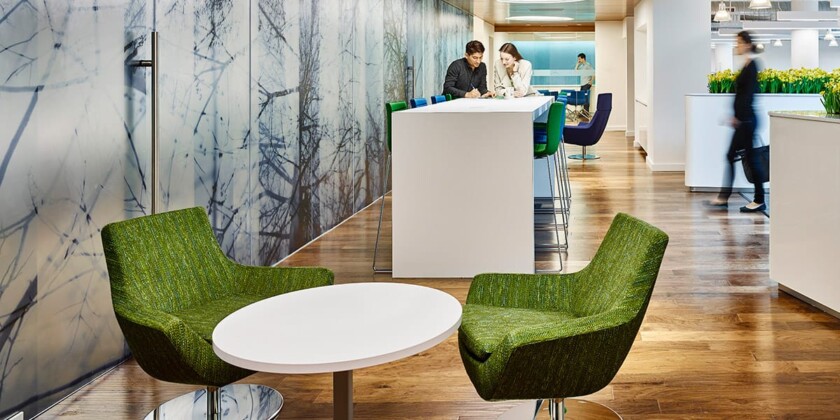
Result:
The selection of Fogelson’s Neil’s Branches artwork from Skyline Design’s Digital Glass Portfolio fosters a connection between the work culture of PCVST and the 80-acre park their new offices are situated on. Reference to the natural landscape and PCVST’s adaptive work style results in a cohesive, unified space that brings art and nature into a dialogue with architecture, while seamlessly integrating the client’s brand into its physical location. “The tree branch graphic provides continuity of color theme and branding throughout the project,” says Mrowiec-Chun. “This was a perfect product to achieve our aim.”
